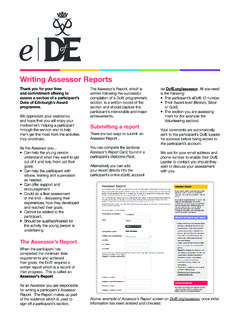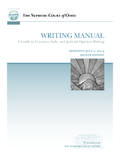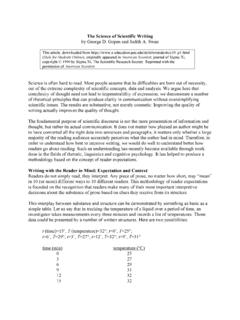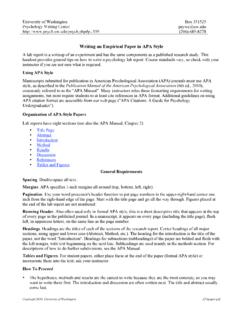Transcription of GETTING THE LANGUAGE RIGHT - summerfoundation.org.au
1 GETTING THE. LANGUAGE RIGHT . A HEALTH PRACTITIONERS' GUIDE TO writing REPORTS, LETTERS, FORMS AND ASSESSMENTS FOR THE NDIS. PREPARED BY: Kir Larwill, Gill Hilton, Cathy Bucolo Summer Foundation, ABN 90 117 719 516. PO Box 208, Blackburn 3180, Victoria, Australia Telephone: +613 9894 7006. 2018 by the Summer Foundation Ltd. A copy of this report is made available under a Creative Commons Attribution Licence (international). CITATION GUIDE. Larwill, K., Hilton, G., Bucolo, C. (2018). GETTING the LANGUAGE RIGHT . Melbourne: Summer Foundation Ltd ACKNOWLEDGEMENTS. This project was funded by the Australian Government Department of Social Services. Thanks to the Victorian Department of Health and Human Services for their support. DISCLAIMERS. The Summer Foundation has contributed information towards this report and believes it to be accurate and reliable. Neither the Summer Foundation nor any contributors make any warranty, expressed or implied, regarding any information, including warranties to accuracy, validity or completeness of information.
2 This guide is for educational purposes and the Summer Foundation cannot be held responsible for any actions taken on the basis of information outlined in this guide. WHY THE WORDS YOU USE MATTER. Communication and mutual understanding are fundamental to working together, but different systems often use different terminology, and come with their own jargon. Knowing how to convey the RIGHT information, in the RIGHT words, from one system to the other, is essential. A great example of this is the term rehabilitation'. In a health context it means restoring someone's functioning as much as possible to pre-injury abilities through allied health therapy and intervention. In a justice setting it means supporting someone who has been convicted of a crime to re-integrate back into society and to counter any future offending. And in the context of drugs and alcohol, rehabilitation describes the process of medical or psychotherapeutic treatment for someone substance-dependent.
3 So, when you use the term rehabilitation, you need to know your audience and the context so that you convey what you really mean. writing for the NDIS is exactly the same. It's important that health practitioners (nurses, doctors, occupational therapists, social workers, discharge planners, physiotherapists, speech pathologists) express necessary information and evidence in a way that feels true and comfortable to them but also meets the NDIS' decision-making criteria. Knowing how to use the terminology required by the NDIS better equips you to: zz Support a person with disability and complex support needs through hospital and health systems zz Connect people to the NDIS (or enable them to change their existing NDIS plans and funding arrangements). zz Contribute to the development of a successful NDIS plan one that properly incorporates the person's health condition(s) and disability, the impact these have on their capacity and functioning, and the supports needed for them to meet their goals and live well zz Work cooperatively so that the person and their family's experience of both systems' is positive, smooth, supported, and free of delays or obstacles to them GETTING out of hospital and on with life GETTING THE LANGUAGE RIGHT JUNE 2018 1.
4 writing FOR THE NDIS. To write effective supporting documentation for people with disabilities and complex support needs seeking access to the NDIS (or needing to change existing plans), you need to get the words RIGHT . Health practitioners need to write about the person's health condition and the impairment as they always have and that's their area of expertise. When writing to support access to NDIS, the NDIA relies on the information provided about a person to assess eligibility and support accurate NDIS plans. People with disability seeking access to NDIS funding need to meet criteria of permanent impairment. This requires health practitioners to: 1. Support people with disability through the steps required to gain access to the NDIS. 2. Make clear connections between the health condition and the impairment, and the impact these have on the person's ability to undertake tasks or activities (activity limitation) and their ability to participate in life roles (participation).
5 To meet the criteria for disability eligibility, you have to show that the impairment substantially reduces the person's functional capacity. To do this, health practitioners need to: 1. Use the LANGUAGE of diagnosis, treatment and rehabilitation to described the condition and the impairment 2. Build on this to write about activity limitation, function and participation. To make this clearer we have developed a diagram to help join the dots between clinical LANGUAGE and what it focusses on, and the words required by NDIS - the LANGUAGE you will need to use in any supporting documentation you provide. The diagram: 1. Shows the progression from medical or health system LANGUAGE to the LANGUAGE of participation consistent with NDIS criteria and terminology. It is based on the World Health Organisation International Classification of Functioning, Disability and Health, familiar to most allied health professionals. 2. Combines the LANGUAGE of the health system with that of the NDIS Act 2013.
6 It aims to show health practitioners how to write for the NDIS how to describe a person's permanent impairment and the related activity limitations which directly affect participation in daily, community and economic life. This is exactly what the NDIS needs to know. 2 GETTING THE LANGUAGE RIGHT JUNE 2018. FOCUS (HOW THE ASSOCIATED. ASSOCIATED writing . PROBLEM' IS WORDS &. DESCRIPTIONS FOR THE NDIS. DEFINED) PHRASES. An abnormal state of Disease ..sustained an Describe the health condition: health Injury acquired brain injury John's acquired brain injury . CONDITION. Illness (ABI) subsequent to HEALTH. Syndrome a cerebral vascular Condition accident (CVA)/. Fracture . Genetic Patient Treatment Problem in body Impaired ..sustained left fronto- Describe the permanent function or body Decreased temporal haematoma impairment: structure Limited with RIGHT upper and has resulted in permanent IMPAIRMENT. Poor lower limb cognitive-communication Contusion Presents with moderate impairment.
7 He has difficulty Hemiparesis to severe, permanent with comprehension and verbal Patient cognitive impairment communication, and his social DISABILITY See definition at the bottom of the page Rehabilitation in areas of attention, functioning is impaired . working memory, impulse . Problem with carrying Aided ..unable to safely Describe how the permanent out a task or activity Needs support with walk more than 100m impairment limits the person's LIMITATION. Unable to activities (functional impairment): ACTIVITY. Requires prompting distressed and angry This permanent impairment is Skill development at local shop keeper severely limiting John's ability to Compensatory when he has to wait have conversations as he used to strategies in items with his children . Patient/Client to purchase due to Rehabilitation memory . Problem with Functional ..isn't working Describe how the functional involvement in life Meaningful activities as continues to impairment limits the person's ability situations Everyday situation forget job interview to fulfil their life roles; the functional social roles limitation to his capacity: Participates in isolated and stays at This is severely impacting on his Context specific has functional capacity PARTICIPATION.
8 Valued outcomes indicated that he will to fulfil his role as father Big Things be banned from shop in the way he did pre-injury. John Meaningful goals if outburst happens requires ongoing capacity building Client /person/ again support from a Speech Pathologist participant to maintain the gains he has made Enabling; maintaining; during rehabilitation in the area of his preventing life, so he can achieve his goal to be deterioration; small, a good dad for his children. SP can slow incremental gains monitor and update his strategies to maintain his current level of functioning. Currently he is able to . DISABILTY: incorporates impairment, activity limitation and participation for a person. The NDIS' focus is at the participation end of the spectrum, which is about the person's goals, life roles, functional capacity. Your documentation, requests and evidence need to include health condition and impairment but should emphasise limitations in their activity and capacity to participate.
9 GETTING THE LANGUAGE RIGHT JUNE 2018 3. Key NDIS terms explained The NDIS terms used in the diagram above are explained further here and are the most important ones for health practitioners to know about and use. Functional impact , functional capacity and functional impairment . A person is considered NDIS-eligible if they have: zz A disability that is attributable to an impairment or condition. Impairment is a recognised intellectual, cognitive, neurological, sensory, physical or psychiatric condition identified by a qualified professional as affecting a person. Generally, impairment refers to the loss of, or damage to, a physical, sensory or mental function1. This is described as functional impairment . z z A lifelong and substantially reduced functional capacity to communicate, interact socially, learn, be mobile, care for or manage themselves, as a result of an impairment. This encompasses being less able to function socially or psychologically when doing these things.
10 Health practitioners need to provide information that enables the NDIS to understand the impact of the condition on the person's life. The information has to convey: z z The impact of a condition on the broad domains of person's life such as their cognitive and intellectual abilities, their neurological state, and their sensory, physical or psychiatric function. z z The impact of the condition and impairment on their functional capacity' how well a person does, or how much help they might need, completing the important everyday activities of life (eating, dressing, GETTING around and communicating) so that they can fulfil family, social, community and economic roles. In your assessment of what supports a person needs, the access request and the evidence you provide should be described in terms of redressing the functional impacts of disability and related health conditions (enabling participation), rather than solely in terms of treatment or diagnosis.







